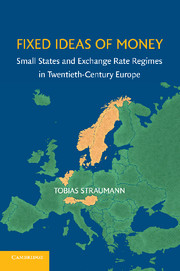Crossref Citations
This Book has been
cited by the following publications. This list is generated based on data provided by Crossref.
Kleivset, Christoffer
2012.
From a Fixed Exchange Rate Regime to Inflation Targeting.
SSRN Electronic Journal,
Hansen, Per H.
2012.
Cooperate or Free Ride?: the Scandinavian central banks, Bank for International Settlements and the Austrian financial crisis of 1931.
Scandinavian Journal of History,
Vol. 37,
Issue. 1,
p.
87.
Urban, Scott
and
Straumann, Tobias
2012.
Still tied by golden fetters: the global response to the US recession of 1937–1938.
Financial History Review,
Vol. 19,
Issue. 1,
p.
21.
Leszczyńska, Cecylia
2013.
Polska polityka pieniężna i walutowa w latach 1924-1936. W systemie Gold Exchange Standard.
Ho, Tai-kuang
2014.
Dilemma of the Silver Standard Economies: The Case of China.
Southern Economic Journal,
Vol. 81,
Issue. 2,
p.
519.
Rosenkranz, Peter
Straumann, Tobias
and
Woitek, Ulrich
2014.
A Small Open Economy in the Great Depression: The Case of Switzerland.
SSRN Electronic Journal,
Germann, Julian
2014.
German “Grand Strategy” and the Rise of Neoliberalism.
International Studies Quarterly,
Vol. 58,
Issue. 4,
p.
706.
James, Harold
2014.
The Cambridge History of Capitalism.
p.
264.
Morys, Matthias
2014.
Gold Standard Lessons for the Eurozone.
JCMS: Journal of Common Market Studies,
Vol. 52,
Issue. 4,
p.
728.
ERIKSSON, MARTIN
2015.
A Golden Combination: The Formation of Monetary Policy in Sweden after World War I.
Enterprise & Society,
Vol. 16,
Issue. 3,
p.
556.
Ho, Tai‐kuang
and
Lai, Cheng‐chung
2016.
A Silver Lifeboat, not Silver Fetters: Why and how the Silver Standard Insulated China from the 1929 Great Depression.
Journal of Applied Econometrics,
Vol. 31,
Issue. 2,
p.
403.
Schenk, Catherine
and
Straumann, Tobias
2016.
Central Banks at a Crossroads.
p.
319.
Baltensperger, Ernst
2016.
Geldpolitik in großen und kleinen Währungsräumen – Was lehrt uns das Beispiel des Schweizer Frankens?.
Perspektiven der Wirtschaftspolitik,
Vol. 17,
Issue. 4,
p.
393.
Ugolini, Stefano
2017.
The Evolution of Central Banking: Theory and History.
p.
207.
Thomassen, Eivind
2017.
Translating central bank independence into Norwegian: central bankers and the diffusion of central bank independence to Norway in the 1990s.
Review of International Political Economy,
Vol. 24,
Issue. 5,
p.
839.
Kugler, Peter
and
Straumann, Tobias
2018.
Handbook of the History of Money and Currency.
p.
1.
Accominotti, Olivier
2018.
Handbook of the History of Money and Currency.
p.
1.
Wansleben, Leon
2018.
How expectations became governable: institutional change and the performative power of central banks.
Theory and Society,
Vol. 47,
Issue. 6,
p.
773.
Kaufmann, Daniel
2019.
Nominal stability over two centuries.
Swiss Journal of Economics and Statistics,
Vol. 155,
Issue. 1,
Knutsen, Sverre
2019.
Profitten setter tonen, og investeringene danser deretter.
Historisk tidsskrift,
Vol. 98,
Issue. 3,
p.
230.



